
- For Parents
- For School Owners
- Our Locations
- Teacher Application
- Dance Schools
- Music Schools
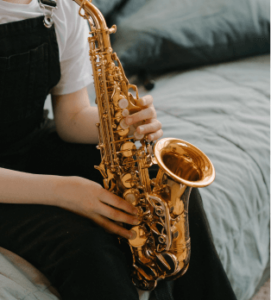

Piano Safari: A Great Piano Method Book for Children

Piano Safari Method Book: A Teacher’s Review
Why do I, a professional piano teacher, think Piano Safari by Julie Knerr is a great method book for children?
It has enjoyable tunes that are humorous and are fun for the young pianist to play and sing. Examples include “I Love Coffee, I Love Tea” and “Charlie Chipmunk.”
Many of the pieces in the Piano Safari books create analogies for children to understand such as bouncing like a kangaroo when they play the “Kangaroo” technique exercise to practice non legato playing and to create a relaxed and bouncy sound. Another example would be playing a loud, long note with a relaxed hand like a lion stuffed animal arm.
Learning Techniques & Activities

The Piano Safari method books consist of many learning techniques and activities that are useful to students and teachers. It contains reading pieces, sight reading exercises, rote pieces, theory, technique exercises, folk tunes, and improvisation. The book leans towards the Intervallic Reading Approach, but primarily uses an Eclectic Method.
Reading pieces in the Piano Safari Repertoire Book One start with just using black keys and printing all the finger numbers on the page for unit one. In unit two, students start playing on the white keys where the hand, note, and finger number are listed. All the finger numbers are also listed on the page. In unit three, students move to the grand staff. They use treble G as the landmark note for right hand and treble clef and bass C as the landmark note for left hand and bass clef. In Piano Safari Book One , students continue to stay on the landmark notes for the rest of the book.
In Piano Safari Book Two , middle C is added as a landmark note in both treble and bass clef. It is not until the middle of Piano Safari Book Two that the students graduate from the landmark notes and start using all the notes on the grand staff. Piano Safari slowly moves the students from black keys, to white keys, and then the grand staff so that students can feel comfortable with reading notes and move at a slow and steady pace. When students start learning the grand staff, intervals are slowly introduced.
In book one, students start with seconds and then move to thirds. In the rest of book one, students practice moving in between seconds and thirds. In book two, they learn fifths, then fourths, and practice playing all the intervals together. In book three, they learn the other intervals such as sixths, sevenths, and octaves. It is great that intervals are introduced at a slow and steady pace so that students can become comfortable with intervals before moving to harder repertoire and sightreading.
Sight Reading Exercises
For sight reading exercises, each method book has a set of color-coded sight reading card supplements, corresponding with the different units for each book or level. The cards are like flash cards. Each sight reading card in level one contains a melodic exercise for right hand in treble clef and a melodic exercise for left hand in bass clef.
In level one, the students will start marching the rhythms and use the syllable “ta” for the quarter notes, “ta-two” for half notes, “ta-ti” for eighth notes, and “ta-two-three-four” for whole notes. In level two, students graduate from marching and saying the ta’s. They move to metric counting, which is what professional musicians use.
For metric counting, the students do not march anymore, they tap the rhythms with both hands . The rhythmic exercises start simple at first such as the left hand playing whole notes while the right hand has a busy rhythm. The difficulty gradually goes up through each unit.
In level two and beyond, the cards will start including exercises where both hands play together. All the cards in every level and unit also contain a rhythmic exercise where the students only practice rhythms.
These methods help contribute to student reading skills.
Training to Play by Ear

One of the most unique activities that Piano Safari offers in its method books are rote pieces.
Rote pieces are ear training pieces where students learn how to play repertoire by ear. They are taught by playing the entire piece for the student first, and then dividing the music into different parts, usually line by line. I will teach one or two measures at a time to them and tell them to think of an animal or fruit name to help with the rhythm.
After the first one or two measures are comfortable with the student, I will gradually add on the next one or two measures and review the previous measures consistently until the first part is learned.
After that, I will use the same system for the second part, and the other parts after that. I also constantly review the previous parts. If there are two hands involved with different melodies and rhythms, I will teach one hand at a time and then teach the other hand.
Rote pieces can take up much time to teach, so typically when I teach a rote piece, I usually stretch it to at least two lessons. Piano Safari includes reminder videos on YouTube for the students to use to remember how to play the piece for when they practice at home.
In each Piano Safari level, a theory book is included that contains new material that the students learn in each unit. Students get to practice writing the different clefs, time signatures, notes, and intervals. The theory book also contains review material in each unit to keep up the students’ skills and help them remember previous material.
A unique aspect that the theory book has is compositional practice. This activity is when students are given the time signature, note values, which note to start on, and which intervals to use. Then, they are instructed to write a melody with the given material. The students are given the opportunity to come up with their own ideas or creative variations on the rote pieces.
Piano Safari contains technique exercises in each level that focus primarily on relaxation. In level one, technique exercises are part of the repertoire book and they start with simple exercises such as playing one note at a time with a strong and relaxed sound. In level two, there is a separate technique book from the repertoire book.
Also in level two, students will start learning basic five-finger patterns in different keys and start early practices into playing scales and arpeggios. Students will start playing triads first before getting into arpeggios. In level three, students start learning Hanon exercises and beginner etudes. Technique exercises are typically taught by rote, then the student reads the music, and lastly the student can transpose the exercise into different keys.
Folk tunes are part of the Piano Safari repertoire books. Usually they are pieces such as “Mary Had a Little Lamb,” “Baa, Baa, Black Sheep,” “The Duke of York,” and “The Bear Went Over the Mountain.” They are similar to the reading pieces where the students practice reading music, but they also use their ears to play the pieces.
Learning the folk tunes introduces students to playing familiar pieces and how to learn songs and pieces that they know on their own by ear and reading music.
Improvisational Exercises

Another interesting activity that Piano Safari offers in its repertoire books are improvisational exercises . In these exercises, the students are told which notes they can play, and the teacher plays a bass line and or a melody. The students play the notes that they are told to play in any order and can make up a rhythm if they stay in time with the teacher. Improvisational exercises allow students to be creative, explore sounds, and imitate the teacher.
Piano Safari Level Breakdown
Here is a break-down of all the different levels.
In Piano Safari level one, the students learn pre-staff notation, the grand staff is introduced, the intervals seconds and thirds are introduced, landmark notes are utilized, and students “march rhythms.” Level one includes a repertoire book, a theory book, and sightreading cards.
In level two, students graduate from landmark notes and start reading all the notes on the staff. They start tapping rhythms, have trickier sight reading examples, and they learn the intervals fourths and fifths. Level two includes a repertoire book, a theory book, a technique book, and sightreading cards. In level three, students learn the other intervals, they start playing more advanced music, and start learning early etude technique exercises.
Level Three
Level three has a repertoire book, a theory book, a technique book, and sightreading cards like level two.
Piano Safari offers all these great activities, and that is one of the reasons that I like to use it with children. My students who have used Piano Safari have developed good habits such as having excellent and relaxed piano technique, they do not look at their hands while reading music, they have a good understanding of rhythm, they are good at using their ears, and they enjoy music.
Enjoying music is the most important thing for students when taking piano lessons. The goal, as teachers, is to keep students wanting to practice and get excited to come to piano lessons. Piano Safari aids the teacher in putting together fun pieces that students enjoy playing and the activities keep students happy and engaged during piano lessons.
Why I Choose to Use This Method Book As a Teaching Guide
As a piano teacher myself, Piano Safari is my favorite method book to use because of all its fun activities it has for children. It goes along with my teaching philosophy which is teaching students good habits at an early age but also teaching them how to enjoy music.
Piano Safari is very helpful for the piano teacher in that it provides teaching guides and teaching videos for teachers to use. It is imperative that teachers always plan before having students, especially when using Piano Safari, because there is so much information to cover. For beginning students especially, piano teachers must plan to make lessons efficient.
When students become more advanced, teachers are mostly reactive to students, meaning students bring in repertoire and teachers aid them on what the students need help with. Piano teachers in general have so much to accomplish with their students. Teachers must break down difficult concepts into something that children can easily understand.
What I appreciate about Piano Safari is that it helps the teachers introduce concepts one at a time to students and slowly walks them through learning how to play piano and become great musicians .
To Conclude
I like to use the Piano Safari book with my students because it has the learning techniques of reading pieces, sight reading exercises, rote pieces, theory activities, technique exercises, folk tunes, and improvisation.
The blended Eclectic Method and intervallic approach create the best of two worlds. The result is a resource that provides students with a great way to read music notation, while learning interesting musical styles and listening skills.
All of Piano Safari’s exercises include fun and silly songs that help students learn to enjoy music and is entertaining for the teachers to teach and introduce new material. I am hopeful that Piano Safari will start to become more popular in the piano teaching world and that more piano teachers will start using this method book for beginning students.
My students have really shown great progress with Piano Safari and they continue to play music and be successful with learning new material. As a music teacher, my goal is to introduce Piano Safari to different piano teachers and encourage teachers to introduce good, early habits and techniques to students so that one day they can become successful pianists.
Author: Marisa Pickard
Marisa Pickard is currently a graduate student at DePaul University studying piano performance and teaches at the Christopher Laughlin School of Music in Northbrook, IL . She earned her Bachelors of Music in piano performance from the University of Alabama. Being an experienced piano teacher, she has taught piano lessons for five years and has served as president of the Music Teachers National Association chapter at the University of Alabama. During one summer, she participated in the Brevard Music Center Summer Institute.

Bibliography
“About Piano Safari.” Piano Safari. Accessed June 4, 2021. https://pianosafari.com/about/about-piano-safari/.
Crappell, Courtney. Teaching Piano Pedagogy: A Guidebook for Training Effective Teachers . New York: Oxford University Press, 2019.
Fisher, Katherine and Julie Knerr. Piano Safari Repertoire Book I . Piano Safari, LLC, 2018.

Start your musical journey today
Terms and Conditions - Privacy Policy

Home » Shop » Note Name Cards

Note Name Cards
The Piano Safari Note Name Cards cover a four octave range from Low C to High C. They are designed to help students instantly recognize notes on the staff. Three suggested methods of introduction are included. This product may be used as a stand alone supplement for any piano method.
Hardcopy version is currently available in the U.S. and Australia. The digital version is available worldwide.
Description
Additional information.
- Reviews (0)
Although we believe that intervallic reading is the primary way students should learn to read music, a secure and instantaneous recognition of every note on the staff is also imperative. The Piano Safari Note Name Cards may be assigned at the beginning of Piano Safari Level 2 when this concept is introduced, or you may opt to begin the process earlier, during Piano Safari Level 1.
The Piano Safari Note Name Cards are ordered from low C to high C. However, this is not a practical order to introduce the cards to students. Therefore, three possible Introduction Approaches are provided. A card for each Introduction Approach is included for the teacher to track the student’s progress.
Product information: 39 Cards
There are no reviews yet.
You must be logged in to post a review.
You may also like…

Repertoire Book 2

Level 2 Pack
Related products.

Sight Reading & Theory for the Older Student Book 1

Repertoire & Technique for the Older Student Book 1

Older Student Level 1 Pack

Repertoire & Technique for the Older Student Book 2
Shop Home Login/Register
Search Piano Safari
Shop piano safari, currency switcher.
Piano Safari Review
by Lauren Lewandowski | Feb 20, 2015 | Reviews
June 2017 Update:
Since writing this review in 2015, I have been teaching the Piano Safari method consistently for two years. I have used it with beginners, adults, and transfer students. I have been extremely impressed with the way students are able to read music by the end of Level 2. This is by far my favorite method for teaching piano!
As I’ve been teaching the series, I’ve also made some supplements along the way. Be sure to check out the free downloads on this page in addition to the Grand Staff Note Speller . The Grand Staff Note Speller coordinates with Level 2 of Piano Safari .

I’ve been very interested in Katherine Fisher and Julie Knerr’s piano method, Piano Safari . I’ve studied piano method books in piano pedagogy courses and am constantly trying new ones with students. Piano Safari is by far the most comprehensive method I’ve seen.
I played through the Level 1 Pack , which includes:
- Repertoire Book
- Sight Reading & Rhythm Cards
- Listening CD
Piano Safari not only uses an intervallic approach to note reading, but also includes rote pieces. The rote pieces will develop the student’s listening skills from the very beginning. The student can use the listening CD to listen to rote pieces before learning the piece with a teacher. The rote pieces allow the student to develop his or her technique and to play beyond the typical level of a first-year student. In the Level 1 Repertoire book, students learn seven different motions (named after animals) that provide a solid foundation for piano technique.
An initial concern for learning rote pieces would be that reading skills might suffer during the time of learning by rote. The teacher can easily supplement learning by rote with the Sight Reading & Rhythm Cards. Each sight reading & rhythm card includes a reading and rhythm example.
The Level 1 Pack is intended to take about a year with students. It may seem like a long time for just one level, but I agree with the creators that the first year is crucial for laying a solid foundation for students.
What if a student is already learning from a different method?
The rote pieces can be purchased as a separate book that also comes with a listening CD. Students can still learn the rote pieces and “animal techniques” while using a different method book. The Sight Reading & Rhythm Cards can also be used without using the repertoire book. I ordered all three levels of the Sight Reading & Rhythm Cards to use with students.
Katherine Fisher and Julie Knerr have a wealth of resources for teachers available on their website . There are teacher guides, videos, and articles.
Katherine and Julie have offered a giveaway of the level one pack to one reader of my blog. If you are interested in trying Piano Safari , leave a comment at the end of this article by February 28. One person will be randomly selected to receive a free Piano Safari level one pack.

Lauren teaches piano to students of all ages in New Orleans, LA. Teaching is her passion. She enjoys creating resources for her students and is the author of Ready for Theory®.
Related posts:

12 Comments
I’m so intrigued by the rote pieces and also the seven animal motions! I think the cards will work really well with some of my students!
This sounds interesting! Count us in!
I like the idea of also using rote to develop listening skills!
This is the best explanation I’ve read of Piano Safari! I now understand how it works and am ready to try it! Thank you!
I love Piano Safari! I have been using it with great success this past year. My students really love the rote pieces.
I have taught for over 30 years and have only used this with one student so far, but it will be my choice for all beginners from now on. It is particularly wonderful for the older beginner as it is void of all the cutesy illustrations. Very respectful and so much is covered.
I’m definitely intrigued!
I’m loving Piano Safari – have been using it with students for about 1 year. It’s not just the rote pieces but the excellent introduction to the fundamental movements required for good piano technique. The internet reminder videos demonstrating exercises and rote pieces are a great resource for students – and they provide a great teacher’s guide, mini essays and other pedagogical resources too.
I have been looking forward to exploring these materials!
This looks interesting. I really like the idea of rote pieces.
is this also for kids?
Yes, it works well for children. I’ve been using it with a 4-year-old and a 9-year-old this year.
Trackbacks/Pingbacks
- Teaching Piano Pieces by Rote | Piano with Lauren - […] February, I wrote a review of the method, Piano Safari. One of the elements of Piano Safari is rote…
- New Product! Grand Staff Note Speller (PDF Download) | Piano with Lauren - […] method. By the way, if you aren’t familiar with the method, be sure to check out my review here. It…
Quick Search
Blog categories.
- Games & Activities
- Group Lessons
- Online Lessons
- Popular Posts
- Ready for Theory
- Repertoire Lists
- Teaching/Practice Tips
- Uncategorized
Please consider making a donation to support this blog and all of its free resources!

Safari Adventure - Intermediate Piano Sheet Music
This is a rhythmic piece set in a Mixolydian mode. The first part starts with the mode on "G" then moves it to a "D" for an expressive middle section. It does a Da Capo back to the mode on "G", ending with a coda on a G7 chord with a suspended 4th. It's a musical adventure with a safari theme!

Download and Print High Quality PDFs
The high quality PDF version of this piece is available to members along with download and print permissions. The PDF features a clean design without illustrations and is therefore perfect for printing. The sheet music above is made available for free personal use only. If you wish to download, print, or use our music in a professional setting please subscribe . Your support helps keep independent music publishing going! 🎵 😇
Forest Green - Late Elementary Piano Sheet Music
Three american folk songs in middle c - elementary piano sheet music, joy to the world - elementary piano sheet music.
Safari Sheet Music (Piano)
Elissa milne.
- Level 22/100 (Beginner)
- Scoring Piano Solo
- Genre New Age & Instrumental
- Availability Download available Not available
Videos for Safari by Elissa Milne
Product information
- Instrumental
- Educational
- Educational_ Instrumental
Related scores
WORLDWIDE shipping
FREE UK delivery over £35
PROUDLY INDEPENDENT since 2001
Browse: Piano Safari (series)
- Showing 10 results per page. 10
- Showing long format results grid.

- View full details
Piano Safari: Pattern Pieces 1
- Author: Fisher, Katherine
- Author: Knerr Hague, Julie
- Arrangement: Piano (PF)
- Publisher: Alfred Publishing
- Catalogue Number: 1470612089
- Date Published: 24th Mar 2017
- Series: Piano Safari
Sheet Music
Usually despatched within 1 working day
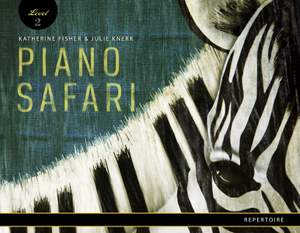
Piano Safari: Repertoire Book 2
- Catalogue Number: 1470611937
- Language: English
- Date Published: 10th Aug 2016
Usually despatched in 2 - 3 working days

Piano Safari: Piece Cards 1
- Editor: Fisher, Katherine
- Edition Information: Accessory
- Catalogue Number: 147061250X
- Date Published: 18th May 2018
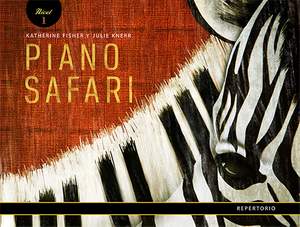
Piano Safari: Repertoire 1 (Spanish Edition)
- Catalogue Number: 1470612631
- Language: Spanish
- Date Published: 5th Dec 2018

Piano Safari for the Older Student Level 2: Repertoire & Technique
- Catalogue Number: 1470613204
- Date Published: 11th Jan 2019
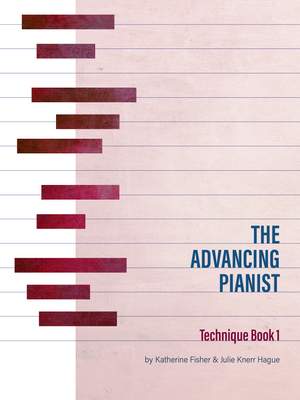
Piano Safari - Advancing Pianist Technique 1
Technique 1
- Catalogue Number: ALF1915466083
- Date Published: 14th Jul 2022

New , Fisher, K: Advancing Pianist Sight Reading 2
- Arrangement: PF
- Catalogue Number: 1915466717
- Date Published: 4th Mar 2024

Piano Safari for the Older Student Level 2: Sight Reading & Theory
- Catalogue Number: 1470613212

J. Knerr-Hague_K. Fisher: Piano Safari: Theory Book 3 - UK Edition
- Catalogue Number: ALF1470613557
- Date Published: 12th Aug 2020
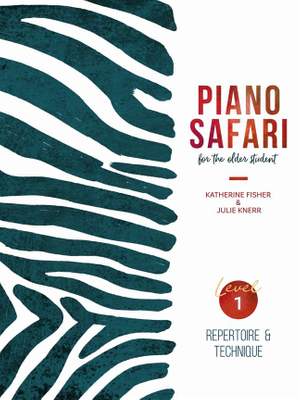
Piano Safari for the Older Student Level 1: Repertoire & Technique
- Catalogue Number: 1470612569
- Date Published: 12th Jul 2018
Download queue
- Clear completed

- Kindle $22.74
- Paperback $32.40
Sold by: Amazon.com Services LLC

The Sight Reading & Rhythm Cards 1 provide reinforcement for reading and rhythm and are an integral part of the Piano Safari Method. Each card has a right hand Reading Exercise, a left hand Reading Exercise, and a Rhythm Tapping Exercise. Five color-coded levels of cards correlate with the five units of Piano Safari Repertoire Book 1. These cards may also be used to supplement any standard method and are useful for both children and adults in private and group class settings.
For more information, videos, and the Teacher Guide, please visit pianosafari.com.

Piano Safari Theory Book 1 correlates with Piano Safari Repertoire Book 1 and the Sight Reading & Rhythm Cards for Book 1 to provide additional reinforcement for each unit.
Concepts included in Theory Book 1:
- Rhythmic values
- Animal Rhythm Patterns
- Landmark Notes
- Intervals of 2nds & 3rds
For more information, please visit pianosafari.com.

Repertoire Book 1 - Spanish Edition is the first book in the Piano Safari Method. This is the Spanish Edition, translated by Juan Cabeza and Marina Alcolea, musicians in Spain. Students ages 6 - 10 begin learning the foundations of piano through this book and the correlating Sight Reading & Rhythm Cards for Book 1 - Spanish Edition. Designed to provide a solid foundation for beginners, Repertoire Book 1 contains key elements that promote the well-rounded development of each student: Rote Pieces, Reading Pieces, Technical Exercises, Improvisation Pieces, and Theory.

The Sight Reading & Rhythm Cards 1 - Spanish Edition provide reinforcement for reading and rhythm and are an integral part of the Piano Safari Method. Each card has a right hand Reading Exercise, a left hand Reading Exercise, and a Rhythm Tapping Exercise. Five color-coded levels of cards correlate with the five units of Piano Safari Repertoire Book 1. These cards may also be used to supplement any standard method and are useful for both children and adults in private and group class settings.

Designed to build on the foundation laid in Level 1, Repertoire Book 2 contains six key elements that promote the well-rounded development of each student. These elements include Reading Pieces, Rote Pieces, Challenge Pieces, Equal Part Duets, Theory, and Improvisation. This book correlates with Technique Book 2 and Sight Reading & Rhythm Cards 2.
- Paperback $31.05

Technique Book 2 is designed to accompany Repertoire Book 2 and Sight Reading & Rhythm Cards 2, but it may be used with any method as a technical supplement. It contains three categories of exercises: Pentascales, Triads, and Special Exercises.
- Kindle $11.99
- Paperback $20.52

The Sight Reading & Rhythm Cards 2 provide reinforcement for reading and rhythm and are an integral part of the Piano Safari Method. Each card has a Reading Exercises on the grand staff or for right and left hands and a Rhythm Tapping Exercise. Six color-coded levels of cards correlate with the six units of Piano Safari Repertoire Book 2. The intervals of 2nds, 3rds, 4ths, and 5ths are presented.
These cards may also be used to supplement any standard method and are useful for both children and adults in private and group class settings.

Piano Safari Theory Book 2 correlates with Piano Safari Repertoire Book 2, Technique Book 2, and the Sight Reading & Rhythm Cards for Book 2 to provide additional reinforcement for each unit.
Concepts included in Theory Book 2:
- Metric counting and rhythmic values
- Grand Staff and note identification
- Accidentals
- Intervals of 2nds, 3rds, 4ths, and 5ths.

Designed to build on the foundation laid in Level 2, Repertoire Book 3 repertoire in the keys of C Major, A Minor, G Major, E Minor, F Major, and D Minor from the Classical and Romantic periods as well as newly composed pieces in a variety of styles.
This book correlates with Technique Book 3 and Sight Reading & Rhythm Cards 3.

Technique Book 3 is designed to accompany Repertoire Book 3 and Sight Reading & Rhythm Cards 3, but it may be used with any method as a technical supplement. It introduces technical patterns such as scales, chord inversions, chord progressions, and accompaniment patterns in the keys of C Major, A Minor, G Major, E Minor, F Major, and D Minor.

The Sight Reading & Rhythm Cards 3 provide reinforcement for reading and rhythm and are an integral part of the Piano Safari Method. Each card has a Reading Exercise and a Rhythm Tapping Exercise. Seven color-coded levels of cards correlate with the seven units of Piano Safari Repertoire Book 3 and Piano Safari Technique Book 3. The Reading Exercises feature the keys of C Major, A Minor, G Major, E Minor, F Major, and D Minor in four textures: pattern, two-voice counterpoint, accompaniment patterns, and chorale style.

Piano Safari Theory Book 3 correlates with Piano Safari Repertoire Book 3, Technique Book 3, and the Sight Reading & Rhythm Cards for Book 3 to provide additional reinforcement for each unit.
Concepts included in Theory Book 3:
- Major, minor, diminished and augmented pentascales and triads
- Keys of C major, A Minor, G Major, E Minor, F Major, and D Minor
- Scales, chord inversions, and chord progressions
- Letter name and Roman numeral analysis

Designed for our youngest students, ages 4 to 6, Piano Safari Friends is intended to lay the foundation for a successful start in Level 1. Its aim is to provide young children with rich and enjoyable musical experiences through movement, singing, imitating, improvising, and learning the fundamentals of rhythmic notation and pre-staff reading.
Customers who bought from this series also bought

Report an issue with this series
Is this series page incomplete or incorrect? Tell us.
Customer reviews
Customer Reviews, including Product Star Ratings help customers to learn more about the product and decide whether it is the right product for them.
To calculate the overall star rating and percentage breakdown by star, we don’t use a simple average. Instead, our system considers things like how recent a review is and if the reviewer bought the item on Amazon. It also analyzed reviews to verify trustworthiness.
No customer reviews

DR. JULIE KNERR HAGUE is the coauthor, with Katherine Fisher, of the Piano Safari Method. Find more information at pianosafari.com. Julie taught applied piano, piano pedagogy, and group piano as a faculty member at the University of Missouri, Oklahoma City University, Ohio University, and the Hartt School Community Division. She currently teachers piano at her home studio in Connecticut.
Julie holds a PhD in Music Education with an emphasis in Piano Pedagogy from the University of Oklahoma, where her dissertation on elementary level piano technique was nominated for the Best PhD Dissertation Award in 2006. Additional degrees include MM degrees in Piano Performance and Piano Pedagogy from the University of Illinois at Urbana-Champaign and a BM in Piano Performance from the University of Puget Sound. Her mentors in piano pedagogy include Jane Magrath, Barbara Fast, Christos Tsitsaros, and Reid Alexander.
Julie is a frequent lecturer and adjudicator at festivals throughout the United States. Her current research interests include elementary level piano technique, lesser known pre-college piano repertoire, and group piano pedagogy.
- Amazon Newsletter
- About Amazon
- Accessibility
- Sustainability
- Press Center
- Investor Relations
- Amazon Devices
- Amazon Science
- Start Selling with Amazon
- Sell apps on Amazon
- Supply to Amazon
- Protect & Build Your Brand
- Become an Affiliate
- Become a Delivery Driver
- Start a Package Delivery Business
- Advertise Your Products
- Self-Publish with Us
- Host an Amazon Hub
- › See More Ways to Make Money
- Amazon Visa
- Amazon Store Card
- Amazon Secured Card
- Amazon Business Card
- Shop with Points
- Credit Card Marketplace
- Reload Your Balance
- Amazon Currency Converter
- Your Account
- Your Orders
- Shipping Rates & Policies
- Amazon Prime
- Returns & Replacements
- Manage Your Content and Devices
- Recalls and Product Safety Alerts
- Conditions of Use
- Privacy Notice
- Consumer Health Data Privacy Disclosure
- Your Ads Privacy Choices
.

COMMENTS
Piano Safari Offers: A carefully sequenced, intervallic approach for learning to read music notation Patterned pieces taught by rote that provide engaging music for students from the first lesson Animal themed Technique Exercises that teach the basic motions of piano technique Improvisation ideas for developing creativity A holistic approach combining ears, eyes, and imagination that allows ...
Piano Safari teaches note reading in addition to playing by rote. Check out this post for how to teach piano music by rote. Lauren Lewandowski. Lauren teaches piano to students of all ages in New Orleans, LA. Teaching is her passion. She enjoys creating resources for her students and is the author of Ready for Theory®.
Learn to play piano on your phone! Easy tutorials with Perfect Piano App and Walk Band Apps. Subscribe for quick lessons and play anywhere! My Whatsapp Chann...
Note Naming Worksheets - Treble and Bass Clef Notes (PDF) Piano Safari Interval Cards. 6/8 Time Signature Worksheets. Piano Safari Technique Reference Sheets 1 Comment Amy Chaplin on April 7, 2016 at 12:48 pm
Continue the safari This page contains links to teacher resources for Piano Safari Level 2, including: Repertoire Book 2 Table of Contents, Certificate, and Teacher Guide for 2018 and 2008 editions Accompaniment Transpositions Unit Maps Technique Book 2 Teacher Guide Sight Reading & Rhythm Cards 2 Pattern Pieces Book 2 Video Links If you need to purchase products for our method, please visit ...
If you already have the products listed on this page, you can find the teacher guides you need organized by level in our Piano Safari Teacher Resources section. Note: a code for corresponding audio tracks is located in the front cover of the Repertoire Book 1 and Repertoire Book 2. Level 1
The Piano Safari method books consist of many learning techniques and activities that are useful to students and teachers. It contains reading pieces, sight reading exercises, rote pieces, theory, technique exercises, folk tunes, and improvisation. The book leans towards the Intervallic Reading Approach, but primarily uses an Eclectic Method.
Lauren Lewandowski. Lauren teaches piano to students of all ages in New Orleans, LA. Teaching is her passion. She enjoys creating resources for her students and is the author of Ready for Theory®. This free PDF has an image of each Piano Safari animal exercise so that you can easily reference a technique while teaching.
The Piano Safari Note Name Cards may be assigned at the beginning of Piano Safari Level 2 when this concept is introduced, or you may opt to begin the process earlier, during Piano Safari Level 1. The Piano Safari Note Name Cards are ordered from low C to high C. However, this is not a practical order to introduce the cards to students.
Lauren Lewandowski. Lauren teaches piano to students of all ages in New Orleans, LA. Teaching is her passion. She enjoys creating resources for her students and is the author of Ready for Theory®. Piano Safari review of Katherine Fisher & Julie Knerr's piano method book. The creators have also offered a free giveaway of the level 1 pack.
Subscribe to Sunrise Piano. Subscribe now. This is a rhythmic piece set in a Mixolydian mode. The first part starts with the mode on "G" then moves it to a "D" for an expressive middle section. It does a Da Capo back to the mode on "G", ending with a coda on a G7 chord with a suspended 4th. It's a musical adventure with a safari theme!
Official Sheet Music: Download "Safari" by (Elissa Milne) for Piano Solo - Download (PDF), Print & Play 20,000+ more Pieces - audio samples (video) · Genre: New Age & Instrumental ... 0 Login. Charts; New on OKTAV; Gift cards; Stories; Safari Sheet Music (Piano) Elissa Milne. Open free preview . Page 1/2. Other arrangements are available in ...
Safari Sheet music for Piano: Music Notes. Time for Summer — Time for Music: 90% OFF 03d: 17h: 17m: 41s. View offer. Official Score of Safari by Official Author arranged for Piano (Solo)
Solo)" by. Billy. Vaughn, Elvis. Presley. What are Official Scores? They are 44,837 scores licensed from leading print publishers to stream on desktop and the MuseScore mobile app. View professionally transcribed scores licensed from the leading publishers.
Arrangement: Piano (PF) Edition Information: Set of Books Publisher: Alfred Publishing Catalogue Number: 1470612038 Language: English Date Published: 3rd Oct 2016 Series: Piano Safari
Billy Vaughn, Bert Kaempfert & His Orchestra, Bert Kaempfert. Browse our 6 arrangements of "A Swingin' Safari." Sheet music is available for Piano, Alto Saxophone, Baritone Horn and 17 others with 3 scorings in 7 genres. Find your perfect arrangement and access a variety of transpositions so you can print and play instantly, anywhere.
100%. F, d. Download and print in PDF or MIDI free sheet music for swinging safari arranged by marcus.jansson.54 for Piano (Solo)
Piano Safari presents a well-rounded approach to music development at the piano that includes Rote Pieces (imitating the teacher's notes, rhythm, technique, and phrasing), Reading Pieces and correlating Sight Reading Cards using an intervallic approach, Technique Exercises and Pieces based on Dr. Julie Knerr Hague's dissertation research ...
Size and Color: 0.75 x 11.5 x 8.25 inches. Age: 3+ yrs. The Piano Notes Wood Sound Puzzle is part of our Friends of Safari collection. Puzzles are an excellent learning tool that help children develop cognitive skills like color and pattern recognition, hand-eye coordination, matching, and more.Characteristics: Durable wood puzzle pieces ...